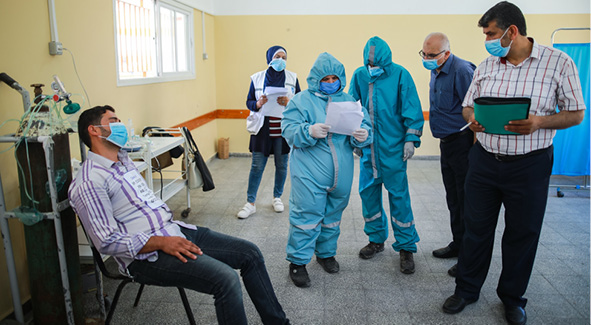“Iwas afraid for my children,” Mona Abu Omar, 40, recalls of the first days of the COVID-19 outbreak in the Gaza Strip. “They said, ‘Don’t be afraid to hug us, Mama, we know that you are taking all precautions.’” In late August, Muna was sent with a day’s notice to staff a tent triage center in front of the local hospital. Every day she saw dozens of people believed to be infected with the deadly virus. The mother of five worked eight-hour shifts, returning to the triage center after lunch to make sure the second shift was ready to go. There are countless reasons for Muna and her family to be concerned about COVID-19 and its spread among the Gaza Strip’s two million residents. Gaza is one of the most crowded places on earth, with limited access to essential medical equipment and pharmaceuticals due to a 12-year blockade. “The blockade is a real problem,” Muna says. Medical supplies and pharmaceuticals are often in low supply, as are laboratory testing kits and supplies for COVID-19. For a year and a half, the health system struggled to keep up with debilitating injuries, including gunshot wounds, incurred at weekly demonstrations at the fence with Israel. The demonstrations ended last December. Many believe that Gaza’s hospitals and clinics remain on the verge of collapse.
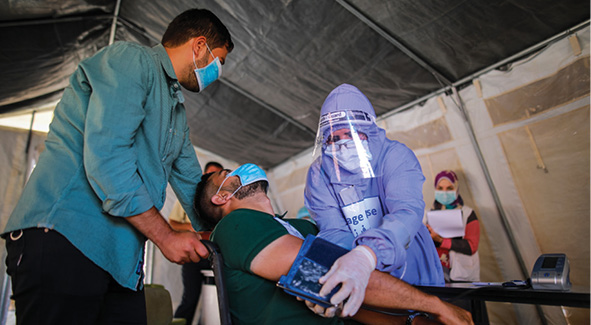
Muna, pictured above, had always wanted to be a doctor. “I didn’t have the chance,” she says, still wistful. Instead, she studied nursing, seeing tens of patients a day at a Khan Younis clinic where she is the head nurse. As the COVID-19 pandemic began, Muna and other frontline health workers took up new training opportunities, where for five days, they learned how to identify and manage suspected COVID-19 patients and how to use protective gear and prevent transmission. “The training was excellent. [It showed us] how to treat for the virus…After receiving the training, I feel confident that I can help those infected and stay safe at the same time,” Muna said after the course. Training and mitigation measures are vital to preventing COVID-19 from spreading unchecked through the territory. Recognizing this in the early stages of the pandemic, the World Health Organization (WHO) worked with the European Civil Protection and Humanitarian Aid Operations (ECHO), a key donor, to adapt its Trauma and Emergency Care Programme to the COVID-19 pandemic – while focusing on injuries and emergency preparedness.
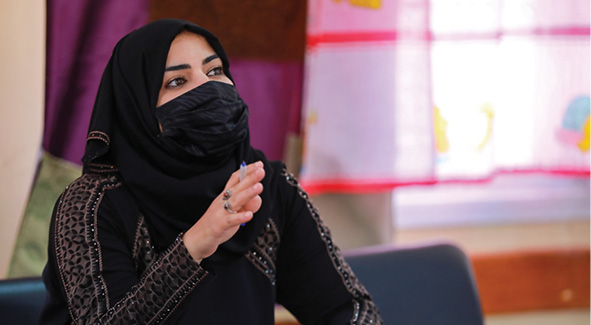
Despite the immense challenges that face the health system in Gaza and her early fears, Muna was satisfied that she knew how to protect herself and her family, because she and nearly 350 Ministry of Health staff and emergency responders from the Palestine Red Crescent Society, such as nurses, doctors, and paramedics, had been trained in handling COVID-19 patients through WHO’s simulations. The training courses, where health workers practiced on actors (see photo at the top of page 36 with Muna looking on), were set up and delivered by the WHO and MDM-France in partnership with the local health authorities. The training ensured that Ministry of Health health workers were able to operate in newly established respiratory triage centers set up by the WHO and partners outside Gaza’s five main hospitals. The centers screen patients for COVID-19 prior to entry to help prevent further spread of the virus into the health system. The WHO provided personal protective equipment and infection prevention and control materials to ensure that frontline health workers, such as paramedics, are able to do their jobs safely.
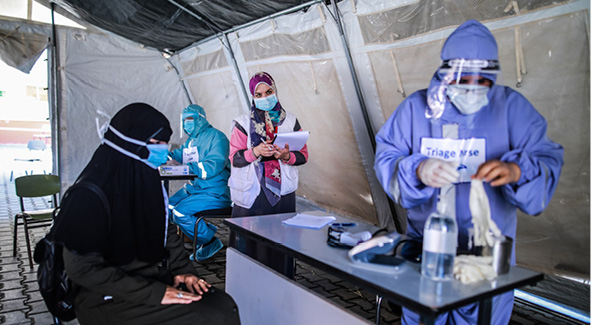
In August 2020, after four individuals tested positive for COVID-19 inside Gaza, Muna and other trainees received suspected cases at one of five tent triage centers. Through the use of a computerized system, patients were given a score, tested for the virus when needed, and treated for respiratory or other symptoms. Once the outbreak slowed, the hospital took over operations at the tent triage center, and Muna returned to her work at the clinic. Patients are met at the door by a nurse who does the initial screening and temperature check before directing incoming cases to Muna and another doctor.
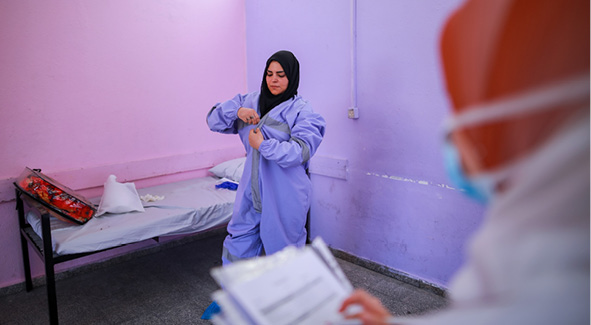
“Humanitarian aid from the EU has been vital in heading off a real disaster here in the Gaza Strip,” says Dr. Gerald Rockenschaub, WHO Head of Office for the occupied Palestinian territories. “Without their agile response, allowing us to adjust our trauma program to the COVID-19 pandemic, we would not have been able to fund and establish training and mitigation measures, and the people of Gaza could be left to suffer in this pandemic, given their weakened medical system and lack of access.” In the photo below, a paramedic in protective gear cleans a Palestine Red Crescent Society ambulance after a COVID-19 simulation exercise supported by WHO.
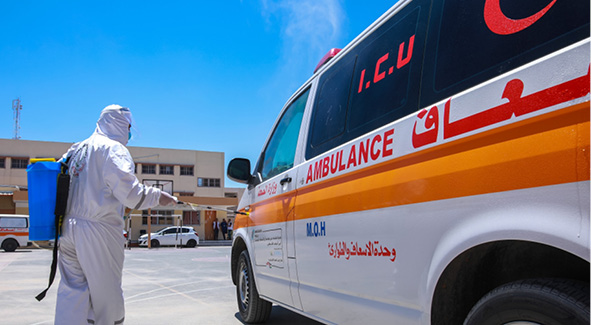
“The role of the WHO is to provide technical and practical support to the medical teams at the Ministry of Health,” says Dr. Rockenschaub, “allowing them to carry out their work safely and effectively.” Muna has gone on to use her experience to train some 30 members of Ard El Insan, a local health services organization where her husband is employed as a doctor, in basic infection prevention and use of protective equipment. “The core of my job as a nurse is to help people,” she says. “It’s very nice to help people and to empathize with them.” In the photo above, health workers consult with other medical staff as they train in COVID-19 preparedness.
